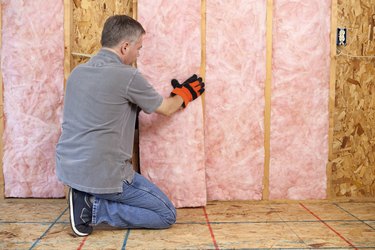
Fiberglass insulation is one of the most common forms of insulation used today, both in the United States and in other countries. It can be applied in a variety of forms and comes in a variety of colors, which makes it confusing when determining which one to use. Between the white, brown, pink, green and yellow options, buyers are frequently left wondering what the differences are between the various colors of fiberglass insulation – if any differences are present at all. The truth is less dramatic than confused buyers would expect, however. The difference in color is generally a matter of trademark.
Pink Versus Yellow Insulation
Video of the Day
In terms of their ability to insulate a space, every form of fiberglass insulation – regardless of color – is functionally identical. All colors can be installed by blow in or laid in as solid, pre-sized panels known as batts and contain essentially the same materials: spun glass fibers bound by resins at high temperatures.
Video of the Day
The core difference in colors is simply that certain manufacturers have trademarked specific colors. For example, Owens Corning is the only company allowed to produce pink fiberglass insulation, while Johns Manville holds the trademark for the white and green colors. Yellow insulation, then, can be considered the generic color – though again, the differences are negligible.
Fiberglass Insulation and Asbestos
While some have voiced concerns that fiberglass insulation contains asbestos, this is actually a misconception, rooted in two misunderstandings. Touching the insulation bare-handed or breathing in an area where fiberglass insulation has been worked with can irritate the skin, eyes, nose and throat, but this irritation comes from the fact that the colorful, fluffy insulation is made of tiny glass shards.
While fiberglass insulation doesn't generally cause health hazards, working with it, especially when it's being blown in rather than laid out in batts, can release a cloud of particles that can act as irritants. And, while there's a relationship between fiberglass insulation and asbestos, it's a positive one: Fiberglass replaced asbestos as the primary form of insulation after reports were released highlighting the health hazards of asbestos. When purchasing it, you don't need to worry about asbestos exposure.
Alternative Insulation Types
Though fiberglass insulation is the most commonly used type of insulation at the moment, a variety of alternatives exist. Two of the most common alternatives include cellulose fiber insulation, also known as denim or newspaper insulation, and spray foam insulation – each of which has their positives and negatives depending on the situation.
Cellulose is the most environmentally friendly and inexpensive form of insulation and can reach tighter spaces when blown in than fiberglass can, though it doesn't act as a moisture seal and must be kept dry. Spray foam is the heaviest, most expensive insulation type and must be applied by a professional, but it creates an air seal that won't retain water or entice pests. Both are just as viable as fiberglass insulation but are best used in specific situations.
- HomeLogic UK: How to Identify Asbestos in Fibreglass Insulation
- Elko Daily Free Press: Professor Hanington's Speaking of Science - The science of fiberglass
- MyHomeScience: What is the difference between pink and yellow fiberglass batts?
- RetroFoam of Michigan: What is the Best Attic Insulation? (Spray Foam vs Fiberglass vs Cellulose)
- RetroFoam of Michigan: Foam vs Fiberglass vs Cellulose: Which Insulation is Best for My Existing House?
- Lowe's: Insulation Buying Guide
- Benardi Building Supplies: The Basics of Pink Insulation
- CertainTeed: Questions and Answers About Formaldehyde and Fiber Glass Insulation